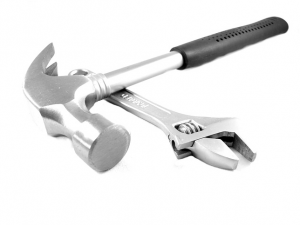DIY Essentials: Skills a First Time Buyer Needs
This entry was posted on Oct 31, 2014 by speedy-bedYour first home is a big purchase, you’ll be spending more money than you’ve ever spent on anything else in your life. However, you don’t stop spending when the house is bought – if anything it’s only just starting.
Even if your house is a ‘ready to move in’ job, chances are you’re still going to need to do a little bit of DIY here and there. By putting together a basic toolkit, you’ll be prepared for all sorts of jobs that your home could throw at you:
Preparing Walls
Whether you’ve bought a new build or an older home, making sure that the walls have a decent finish is essential. There are several things that you may need to do to create this smooth finish, including:
Stripping wallpaper – you can either use chemicals or a steamer to loosen the glue and peel the wallpaper off. Some wallpaper will come off easily while others will be an absolute pain – use a scraping knife, but be careful not to scratch the wall.
Filling cracks, holes and dents – clean the area and then spread filler into and over the imperfections with a palette knife. Try not to put it on too thickly but make sure it stands a bit further out than the wall.
Removing bumps and lumps – this could come from you filling the cracks or previous incidents. You will need to sandpaper the area down with a fine grain paper until you have a smooth, flat wall.
Make sure that you always give the wall a final brush down and wet clean to get rid of any residue left over from sanding or excess filler.
Cutting Wood
You’ll be surprised by how many times you’ll have to cut wood in your new home. It may be that you need to cut down doors or build your own shelves or maybe even build a set of stairs. Either way, being able to properly cut wood is a very important life skill. There are two main ways to do this, both require accurate measuring and marking beforehand:
By hand – you need to choose the right saw for the job and make the initial cuts – this will be done my moving the saw in one direction on the waste side of your marking cut. Once you get a grove, make sure you maintain a smooth and consistent movement while staying nicely along the line. If you find that you’ve begun to stray, simply pull back and start from the previous section.
Power tools – for straight lines, a circular saw is your best bet. Make sure that you have the blade lined up with the line you wish to cut and where possible use the guide to ensure it stays level the whole length of the cut. Take your time and make sure to regularly check that the saw is following the line.
When cutting you will be creating a lot of dust, so make sure you are wearing the correct protective clothing and are in an area that is easy to clean.
Drilling Holes
If you haven’t got a power drill, then you need to get one. Drilling holes is a very common DIY task and without a good power drill it becomes difficult, if not impossible. Knowing exactly when, where and how to drill can be a particularly challenging, here’s what you need to know:
Choosing the right bit – there are many different types of drill bit used for different materials, namely: masonry, wood, metal. Make sure you have the right bit for the job at hand – this includes picking the right sizes.
Knowing where to drill – make sure that you properly mark out the area you wish to drill and gauge how deep it needs to be. If drilling into plasterboard, make sure you have the correct wall plugs for the material or that there is a wooden stud behind it.
Drilling the hole - when drilling, make sure that you keep it level and start slowly. Once you’ve made the initial hole you can speed the drill up – depending on what you’re drilling into you may need to apply pressure, although let the drill do most of the cutting work as this will keep the hole even and level.
After the hole is drilled, you will need to make sure the inside is clear of debris – do this by pulling the drill in and out. If you need a smooth finish then it is beneficial to sand down the edges to remove any bits that may be sticking out.
Hanging Gutters
Making sure your gutters are in place and hanging properly is essential to preventing water damage in the home. Fitting guttering is a relatively simple process, however you will need to make sure that you have the correct length of guttering and all the accessories ready before starting.
Fit the brackets – this is a simple process that involves you screwing the guttering directly into the fascia board at relevant points.
Start at the outlet – you will need to start with the part of the guttering that drains the water and then carefully join the other sections, making sure they are supported in the brackets.
Ensuring it is tilted – guttering needs to be angled slightly downwards in order to keep the water flowing to the outlet point, if there are droops in this angle then water can pile up here and overspill.
While you may not need to carry out this process many times, being able to hang gutters will mean you will know what to do when it comes to fixing and cleaning them.

